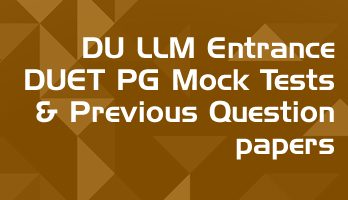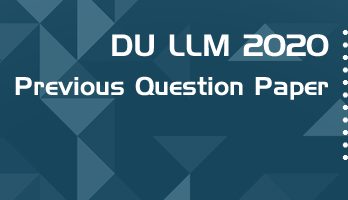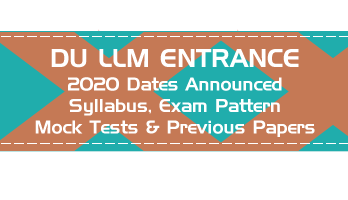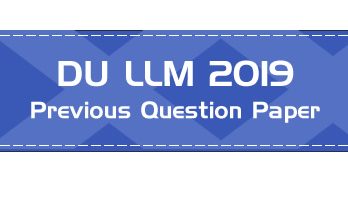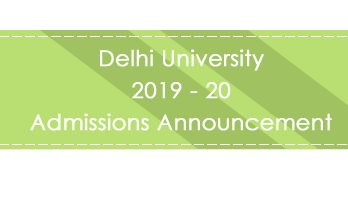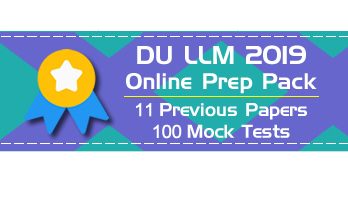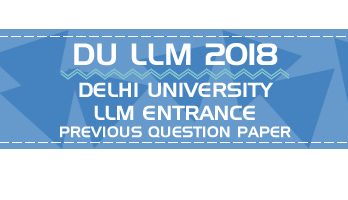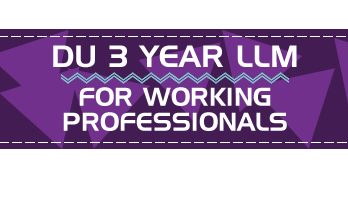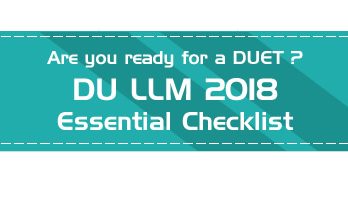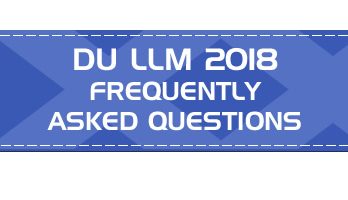- Previous years Question Papers, from 2008 to 2021
- 75 Full Length Mock tests of 100 questions each - from a question bank of 9500+ selected MCQs
- 50 Mini Mock tests of 25 questions each - for quick practice sessions
- Each Full Mock Test is designed as a Model Paper
- Summarized overview of Important Jurisprudence topics
- Overview of all Constitutional Amendments
- All Tests & Previous Papers are timed and have Negative marking for realistic simulation
- Questions & Answer Choices randomly shuffled in every attempt for better practice
- Accessible 24 x 7 via Smart-Phone browsers and Desktops
- Over 100 LawMint users were offered LLM seats in 2020 and 2021- including NLSIU, NALSAR, NLU Delhi and IIT KGP LLM
Authentic Feedback from previous LawMint users :
I got AIR 21 in CLAT PG. Thank you so much. Your mocks helped me a lot in my preparation 🙂 - Ayushi Jain
I have subscribed to your CLAT PG program and got AIR 36 in this year CLAT PG. I have also secured AIR 54 in AILET PG exam. I would like to thank you. Your mock paper really helps a lot - Shrashank Tripathi
I would like to thank you for the CLAT PG LLM COURSE. Practising mock tests there helped me in getting confidence and hence I was able to get AIR 45 in CLAT PG LLM - Akshay Awasthi
A year back, I relied on the IIT Kharagpur RGSOIPL mock test series by LawMint to prepare for my RGSOIPL entrance test. Few months back, I relied on your UGC NET Law series to prepare for UGC NET. I was the topper of the RGSOIPL entrance, and have cracked JRF in UGC NET. All thanks to LawMint - Anshuman Sahoo
"I got AIR 18 in CLAT PG and General Category rank 28 in AILET PG. I want to thank you for helping me practice well in controlled conditions from any place. It gave me a lot of confidence and I took the tests while travelling too. I also made it to IIT Kharagpur." - Vinodharani
"Lawmint has been of great help to me in securing AIR 25 in AILET PG and AIR 29 in CLAT PG examinations. The subjective and objective approach of the test series kept me up to date with the latest exam pattern." - Bhawna Nanda
"I, Nimmy Saira Zachariah joined you clat test series. I cleared AILET PG with 30th rank. Your test series were of immense help as it gave me clear idea of where my preparations stand thank you once again law mint." - Nimmy S Z
"Hey guys. Where do I start? If I thought that getting AIR 59 in Clat PG was it, then how wrong I was. With Lawmint now I have cracked UGC NET as well." - Joyanta Chakraborty
Instructions:
There are 175 questions in this DU LLM Entrance 2015 Test.
Each question shall carry four marks. For every correct answer, four marks will be awarded and for every incorrect answer, one mark will be deducted.
No mark will be awarded or deducted for a question which is left unanswered.
This is not the complete paper. These are the Question headers from the Delhi University LLM Entrance Test – DU LLM Entrance 2015 for general reference. The complete Question paper + the Official Answer keys are available for users registered for LawMint.com DU LLM Online practice packs. Click on the links above to try the free demo mock tests and buy access to the full practice packs.
[1.] Which of the following is a correct pair?
(a) Temple of Preah Vihear case – Res Judicata
(b) Island of Palmas case – Estoppel
(c) U.N. Administrative Tribunal case – Prescription
(d) Chorzow Factory case – Nemo judex in causa sua
[2.] Which one of the following zones was not specifically dealt with under four Geneva Conventions on Law of the Sea of 1958?
[3.] Which of the following instruments entitles an individual to file a petition before Human Rights Committee?
[4.] What is the status of European Commission of Human Rights at present?
[5.] Which of the following international instruments provide for the abolition of death penalty?
[6.] The ILC Draft Code on Responsibility of States for Internationally Wrongful Acts of 2001 lays down……………..as a form of reparation for the injury caused by internationally wrongful act.
[7.] Which of the following is not a principle under Article 2 of the United Nations Charter?
(a) Principle of sovereign equality
(b) Principle of Permanent sovereignty over natural resources
(c) Principle of resolving international disputes by peaceful means
(d) Principle of refraining from the threat or use of force.
[8.] The landlocked States may have access to surplus of the allowable catch in the………. of the Coastal State.
[9.] “Disputes arising out of contract shall be referred to municipal courts of state which grants concession”. This is known as:
(a) Absolute liability theory
(b) Calvo Clause
(c) Blackstonian doctrine
(d) Rule of exhaustion of local remedies
[10.] According to U.N. Convention on Law of the Sea 1982, the Contiguous Zone is established to exercise the control necessary to prevent and punish infringement of coastal state’s laws relating to:
(a) Customs, fiscal, immigration, and sanitation
(b) Security, customs, fiscal, immigration, and sanitation
(c) Environment, Security, customs, fiscal, and sanitation
(d) Research, Security, customs, fiscal, and sanitation
[11.] The Legality of the “Uniting for Peace” Resolution of the General Assembly has been upheld by the International Court of Justice in:
(a) Certain Expenses of the United Nations case
(b) Conditions of Membership in the United Nations case.
(c) Advisory Opinion on the Legality of the Use of Nuclear Weapons case
(d) Nicaragua case
[12.] In maintaining international peace and security, the Security Council has:
[13.] The Agreement of 1994 Relating to the Implementation of Part XI of the U.N. Convention on Law of the Sea is related to:
(a) Fishing at the High Seas
(b) Contiguous zone
(c) Exclusive economic zone
(d) Seabed mining
[14.] Under which Article of the U.N. Charter the Security Council has the power to use force against a State?
[15.] A decision of the International Court of Justice has a binding effect on
[16.] Which of the following constitutes patent-able subject matter?
I. a toxin – where such toxin is found on the skin of a previously unknown tree frog of the Amazon basin, which, when administered to patients with a certain cell cancer, causes a substantial reduction in the number of cancerous cells
II. an idea – where such idea is that there is a mathematical relation among (1) the exposure time of a tumor to a specified alpha-radiation emitting source, (2) the size of the tumor in cubic centimeters, and (3) the success rate of the procedure as determined by survival rate at five years
III. kidney cells – where such cells are found in a certain variety of wild pigs
IV. a new laparoscopic surgical technique – where such technique bears improved results in patient cure
Select the correct answer using the Options given below:
(a) I, II and III
(b) II, III and IV
(c) All of the above
(d) None of the above
[17.] If a trademark is registered in India under the Trade Marks Act, 1999; how long will trademark protection last, assuming renewal?
(a) 20 years from the date of the application
(b) 28 years, plus a renewal term of an additional 28 years, for a total of 56 years
(c) the life of the registrant plus 70 years
(d) potentially forever, if there is continued commercial use
[18.] Note the following:
I. the shape of light bulb, where the shape functions to make the light bulb more energy-efficient and also serves to identity the commercial source of the light bulb
II. the term “Comfortable Shoes” for shoes that have just been introduced to the market
III. the made-up term “Lappy” for a brand of laptops
Which of the following is likely to be granted registration under the present Trade Mark Act, 1999?
(a) I only
(b) II only
(c) I, II, and III
(d) None of I, II, and III
[19.] Which of the following can be patented under the Patents Act, 1970?
[20.] Which of the following is not copyright-able?
(a) a false biography that defames its subject
(b) a database of real phone numbers
(c) the instruction booklet for a useful process
(d) an opera that contains dramatic as well as musical elements
[21.] Copyright could most clearly be claimed over which of the following?
(a) a novel computer programs
(b) a two-word slogan for a chain of fitness centers
(c) the shape of a doorknob
(d) an idea on how one could establish contact with extra terrestrials
[22.] Which of the following is an inchoate crime?
[23]. According to section 57 of Information Technology Act, 2000 a person aggrieved by an order made by the Controller or ar adjudicating officer may prefer an appea to:
(a) Cyber Appellate Tribunal.
(b) High Court
(c) Supreme Court
(d) None the above
[24.] Which word under section 90A of IT Act is substituted for digital signature?
(a) Electronic signature
(b) Internet signature
(c) Computer signature
(d) All above
[25.] What is the appellate authority for the order against National Company Law Appellate Tribunal?
(a) District Court
(b) High Court
(c) Supreme Court
(d) Company Board Committee
[26.] In which of the following cases, the doctrine of Indoor Management was laid down?
(a) Salomon v. Salomon & Co. Ltd.
(b) Ashbury Railway Carriage and Iron Co. Ltd v. Riche
(c) Foss v. Harbottle
(d) Royal British Bank v. Turquand
[27.] In what way the doctrine of ultra vires is applied to the companies?
(a) The activities should be confined within the objects as specified in the Memorandum of Association
(b) The members are not allowed to file a suit on behalf of the company
(c) Employees of the company must work during the office hours
(d) A contract in which directors commit breach of fiduciary duty
[28.] In which of the following cases corporate veil of the company has not been lifted by the court:
(a) Gilford Motor Co. Ltd. v. Home
(b) Daimlmer Co. Ltd v. Continental Tyre & Rubber Co. Ltd.
(c) Dinshaw Maneckjee Petit, Re
(d) People Pleasure Park Co. v. Rohleder.
[29.] The most important feature of a ‘partnership at will’ is:
(a) Sharing of losses
(b) Registration not needed
(c) Easy dissolubility
(d) Utmost Transparency
[30.] The Doctrine of Holding out is an application of the principle of:
(a) Agency
(b) Estoppel
(c) Vicarious liability
(d) Privity of contract
[31.] When a minor, who was admitted to the benefits of Partnership becomes a partner upon attaining the age of majority, his personal liability commences from:
(a) The date of his first admission to benefit of partnership
(b) The date of majority, if he continues in partnership
(c) The date fixed by all the partners
(d) Only his assets or contributions to the partnership is liable
[32]. A partner of an unregistered firm cannot sue:
(a) For enforcing a right under the Partnership Act
(b) For enforcing a right arising out of the partnership contract
(c) For dissolution of Partnership Firm
(d) Both (a) and (b).
[33.] Which of the following cannot be claimed by a partner as a matter of right?
(a) Right to take part in business
(b) Right to have access to account books
(c) Right to share profits
(d) Right to receive remuneration
[34.] A, though involved in a motor accident, remained physically unhurt but suffered Myalgic Encephalomyelitis, a psychiatric illness with which he had earlier suffered but which was then in remission. He claimed damages from the driver of the motor car. Will he succeed?
(a) No, this illness was not foreseeable in a person of normal health
(b) No, he has not suffered any physical injury
(c) Yes, he has suffered injuries by shock.
(d) Yes, though this illness was not foreseeable but foresee-ability of some physical harm was there.
[35.] Under the Consumer Protection Act, 1986, ‘Complaint’ means an allegation of:
i. an unfair trade practice or a restrictive trade practice
ii. defective goods
iii. deficiency in service
iv. charging a price in excess of the price agreed
Select the correct answer:
(a) (i) and (iv)
(b) (i), (ii) and (iii)
(c) (ii) and (iii)
(d) (i), (ii), (iii) and (iv)
[36.] Who among the following cannot be a complainant under the Consumer Protection Act, 1986?
(a) a consumer
(b) consumer’s friend
(c) any voluntary consumer organisation
(d) Central Government or any State Government
[37.] A car mechanic was employed by his master, the defendant to repair cars. He repaired a car and then drove the car for a short distance to check whether he had repaired it properly or not. In the process he caused an accident injuring the plaintiff. The master is:
(a) liable because it was his servant who had negligently caused the accident for which he was vicariously liable
(b) not liable because the mechanic was supposed to repair only and as such driving by him was outside his course of employment
(c) liable because driving was necessarily incidental to the duties of the mechanic since he was duty-bound to check by driving whether the repair he had done were correctly done or not
(d) it depends solely on the discretion of the court in such cases to decide as to whether the master is liable or not
[38.] In deciding the question of negligence by professionals, the classical statement of law which has been widely accepted as decisive of the standard of care required both of professionals generally and medical practitioners in particular is popularly called:
(a) Stephen test
(b) Frien test
(c) Bolam test
(d) Hyde test
[39.] Which of the following statements are not correct?
1. Res ipsa loquitur is used for the purpose of fixation of liability based on strict liability
2. Inference of negligence could properly be drawn in res ipsa loquitut
3. Res ipsa loquitur dispenses wit! taking of evidence
4. Res ipsa loquitur mostly favours th defendant
Select the correct answer using the code given below:
(a) 1, 2 and 3
(b) 1, 3 and 4
(c) 2, 3 and 4
(d) 1, 2 and 4
[40.] In which of the following cases, Justice Kennedy’s limitation to the claims relating to nervous shock that “the shock must have been due to fear of immediate personal injury to oneself was rejected?
(a) King v. Phillips, (1953) 1 QB 429
(b) Dulieu v. White & Sons, (1921) 2 KB 669
(c) Hambrook v. Stokes-Brothers, (1925) 1 KB 141
(d) Mclonghlin v. O’Brien, (1983) 1 AC 410
[41.] Which of the following statements is incorrect?
(a) In Tort, the duties are imposed by law whereas in contract, the duties are undertaken by the parties themselves
(b) In tort, the duty is towards the world at large but in contract, the duty is towards specific individual or individuals
(c) In tort, the damages are liquidated but in contract, the damages are unliquidated
(d) In tort the damages are unliquidated but in contract, the damages are liquidated
[42.] Any amount due from a person under an order made by a Consumer Forum, under the Consumer Protection Act, 1986, can be recovered by:
(a) Collector of the district in the same manner as arrears of land revenue
(b) The Consumer Forum by an order of attachment of property
(c) Collector of the district by an order of attachment of property
(d) The Consumer Forum in the same manner as arrears of land revenue
[43.] Which one of the following disputes cannot be raised before the Consumer Forum?
(a) A dispute relating to services by a government servant
(b) A dispute relating to services provided by the medical professional
(c) A dispute relating to banking service
(d) A dispute relating to insurance services
[44.] Which of the following statements is correct?
(a) The liability of master and servant is joint
(b) The liability of master and servant is several
(c) The liability of master and servant is sometimes joint and sometimes several depending on circumstances
(d) The liability of master and servant is joint and several
[45.] In which of the following cases, insulting words cannot for the basis of an action of defamation?
(a) written in a post card
(b) written in a group whats app message
(c) written in an inland letter
(d) written on the notice board
[46.] What was the rule laid down by the Privy Council in “Wagon Mound” case?
(a) The defendant is liable only for that injury which could be reasonably foreseen as occurring due to defendant’s fault
(b) The defendant is liable for all the injuries which occur as a direct consequence of defendant fault
(c) The defendant is not liable, unless the plaintiff proves that he suffered injuries due to defendant’s negligence
(d) The defendant is not liable if he proves that the plaintiff suffered injury owing to his contributory negligence
[47.] Which of the following acts invites tortious liability and is not saved by the Doctrine “Volenti Non Fit Injuria”?
(a) A surgeon amputates a limb of a patient to save his life
(b) Injury is caused while play-fighting with the naked swords at a religious function
(c) Injury is caused to a player in a football match
(d) Injury is caused while doing lawful acts under contract
[48.] “A” had constructed a temporary structure on a land belonging to the Municipal Corporation in which he ran a flourishing restaurant that was frequented by elites of the town. The Municipal Corporation constructed a huge Public Toilet in the plot adjoining A’s famous restaurant. Does A have any remedy under the law of tort?
(a) He has no remedy because he did not own the plot
(b) He has remedy to get the Municipal Corporations’ action stopped as it constituted a nuisance
(c) He had the freedom to hedge the restaurant by erecting screens and boards
(d) None of the above
[49.] Injuria Sine Damnum relates to cases where there is:
(a) An invasion of an absolute private right
(b) An invasion of a public right
(c) A violation of a legal right
(d) A legally authorized act resulting in injury
[50.] X wants to purchase V’s car and drives it to test it with Y seated by his side. Because of X’s negligence an accident occurs and “Z” is injured. Z sues Y for damages. In this case:
(a) Y is not liable as X was driving the car for his own purpose.
(b) Y is not liable as X was not the servant of Y
(c) Y is liable because he had not abandoned his right and duty to control the way in which the car was driven
(d) Y is liable because X was driving the car for Y’s purpose.
- Previous years Question Papers, from 2008 to 2021
- 75 Full Length Mock tests of 100 questions each - from a question bank of 9500+ selected MCQs
- 50 Mini Mock tests of 25 questions each - for quick practice sessions
- Each Full Mock Test is designed as a Model Paper
- Summarized overview of Important Jurisprudence topics
- Overview of all Constitutional Amendments
- All Tests & Previous Papers are timed and have Negative marking for realistic simulation
- Questions & Answer Choices randomly shuffled in every attempt for better practice
- Accessible 24 x 7 via Smart-Phone browsers and Desktops
- Over 100 LawMint users were offered LLM seats in 2020 and 2021- including NLSIU, NALSAR, NLU Delhi and IIT KGP LLM
Authentic Feedback from previous LawMint users :
I got AIR 21 in CLAT PG. Thank you so much. Your mocks helped me a lot in my preparation 🙂 - Ayushi Jain
I have subscribed to your CLAT PG program and got AIR 36 in this year CLAT PG. I have also secured AIR 54 in AILET PG exam. I would like to thank you. Your mock paper really helps a lot - Shrashank Tripathi
I would like to thank you for the CLAT PG LLM COURSE. Practising mock tests there helped me in getting confidence and hence I was able to get AIR 45 in CLAT PG LLM - Akshay Awasthi
A year back, I relied on the IIT Kharagpur RGSOIPL mock test series by LawMint to prepare for my RGSOIPL entrance test. Few months back, I relied on your UGC NET Law series to prepare for UGC NET. I was the topper of the RGSOIPL entrance, and have cracked JRF in UGC NET. All thanks to LawMint - Anshuman Sahoo
"I got AIR 18 in CLAT PG and General Category rank 28 in AILET PG. I want to thank you for helping me practice well in controlled conditions from any place. It gave me a lot of confidence and I took the tests while travelling too. I also made it to IIT Kharagpur." - Vinodharani
"Lawmint has been of great help to me in securing AIR 25 in AILET PG and AIR 29 in CLAT PG examinations. The subjective and objective approach of the test series kept me up to date with the latest exam pattern." - Bhawna Nanda
"I, Nimmy Saira Zachariah joined you clat test series. I cleared AILET PG with 30th rank. Your test series were of immense help as it gave me clear idea of where my preparations stand thank you once again law mint." - Nimmy S Z
"Hey guys. Where do I start? If I thought that getting AIR 59 in Clat PG was it, then how wrong I was. With Lawmint now I have cracked UGC NET as well." - Joyanta Chakraborty
[51.] Owing to the negligence of the defendant railway company, the plaintiff and his family were made to get down at the wrong railway station. No accommodation was provided. As a result, the plaintiffs wife caught cold. The plaintiff claimed damages for consequential loss on account of medical expenses incurred for her treatment and her loss due to pay-cut in office. The claim for damages will not succeed on ground of:
(a) Unreasonableness
(b) Remoteness of damage
(c) Plaintiff own over-sensitive health
(d) Magnifying a small discomfort
[52.] Which one of the following statement is correct:
(a) In case of absolute privilege, action can lie for a defamatory statement made without malice
(b) In matters of qualified privilege n( action lies for a defamatory statement even though the statement is false c has been made maliciously
(c) In matters of absolute privilege, n action lies for a defamatory statement even though the statement is false < has been made maliciously
(d) In matter of qualified privilege, action can lie for a defamatory statement made without malice
[53.] A lawful act does not become unlawful even if it was done with evil motive. T! was held in:
(a) Ashby v. White
(b) Mayor of Bradford Corpn. v. Pickles
(c) Christie v. Devey
(d) Hollywood Silver Fox Farm Ltd. v. Emmett
[54.] The Supreme Court brought services provided by medical professionals within the ambit of Consumer Protection Act, 1986 in the case of:
(a) Spring Meadows Hospital v. Harjol Ahluwalia
(b) Indian Medical Association v. V.P. Shantha
(c) Vishakha v. State of Rajasthan
(d) P. Narasimha Rao v. G. Jayaprakasu
[55.] An order under section 24 of the Hindu Marriage Act, 1955:
(a) is an interlocutory order and no appeal lies against it
(b) is an appealable order generally
(c) is an appealable order but with the leave of the court only
(d) may be appealable depending upon the sole discretion of the court
[56.] Under Hindu law, in relation to the children of void marriages:
(a) a court declaration is necessary to confer a status of legitimacy
(b) a court declaration is not necessary to confer a status of legitimacy
(c) such a child becomes legitimate after reaching the age of 18 years
(d) such a child cannot become legitimate
[57.] Under Hindu law, if a minor marries without the consent of the parents/ guardian, the marriage would be:
(a) Invalid
(b) Void
(c) Valid
(d) Both (a) and (b)
[58.] Match List I with List II and select the correct answer using the Options gives below:
[List I]
A. Marriage between parties within degrees of prohibited relationship
B. Impotency
C. Marriage between, two parties who are sapindas of each other
D. Pregnancy of wife at the time of marriage by some person other than the petition
[List II ]
1. Voidable
2. Void
3. Voidable
4. Void
(a) A-1,B- 1,C-3,D-4
(b) A-2,B- 3,C-1,D-4
(c) A-2, B-1,C-4,D-3
(d) A-2,B- 4,C-1,D-3
[59.] Fine prescribed under section 18 of the Hindu Marriage Act, 1955 for child marriage has been enhanced by the Prohibition of Child Marriage Act, 2006 from one thousand rupees to:
(a) Ten thousand rupees
(b) Fifteen thousand rupees
(c) Fifty thousand rupees
(d) One lakh rupees
[60.] Desertion” within the purview of the Hindu Marriage Act, 1955 is:
(a) a total repudiation of obligations of marriage
(b) a partial repudiation of the obligations of marriage
(c) a suspension of obligations of marriage
(d) equivalent to judicial separation
[61.] ‘A’, a Hindu boy, aged 15 years, marries ‘B’, a Hindu girl, aged 12 years under Hindu Marriage Act, 1955. The marriage was consummated when the girl had attained puberty (which she did at the age of 13). The girl at the age of 17:
(a) can remarry without getting the marriage dissolved.
(b) cannot claim divorce
(c) can seek repudiation of marriage
(d) cannot seek repudiation of marriage
[62.] Hindu Joint Family Property consists of:
(a) All ancestral property
(b) Property acquired with the aid of ancestral property
(c) Separate property of a coparcener which is voluntarily thrown by him into the common stock to such an extent that it cannot be distinguished from Joint Family Property
(d) All of the above
[63.] [Assertion (A):] A bigamous marriage is void under Hindu Law.
[Reason (R):] A child born out of void marriage is deemed as legitimate child of his parents.
(a) Both ‘A’ and ‘R’ are true and ‘R’ is the correct explanation of ‘A’
(b) Both ‘A’ and ‘R’ are true and ‘R’ is not the correct explanation of ‘A’
(c) ‘A’ is true but ‘R’ is false
(d) ‘A’ is false but ‘R’ is true.
[64.] According to the Marriage Laws (Amendment) Act, 2003, every appeal under section 28 of the Hindu Marriage Act, 1955 shall be preferred within:
(a) 45 days from the date of decree or order
(b) 30 days from the date of decree or order
(c) 60 days from the date of decree or order
(d) 90 days from the date of decree or order
[65.] G, a Hindu girl, aged 14 years, marries 1 a Hindu boy, simply by exchange c garlands in a temple in Delhi. Later on, ( finds that B is impotent. G leaves the matrimonial home and marries A. In the following situation:
(a) G can be punished for bigamy
(b) G cannot be punished for bigamy
(c) G cannot be punished for bigamy because her first marriage was nc valid on account of impotency of B
(d) G cannot be punished for bigamy because her first marriage was no valid on account of improper solemnization of marriage
[66.] After the passing of a decree for judicial separation, if one of the spouse disease intestate:
(a) the other spouse can inherit the property of that spouse
(b) the other spouse cannot inherit the property of that spouse
(c) the other spouse can inherit the property of that spouse only with the consent of the children
(d) only the children can inherit the property of that spouse
[67.] Vijay and Saroj was a childless couple. I 1990 Vijay took in adoption his brother’ son Ajay. In 1992, a son was born to the couple. Vijay wants to give Ajay back his brother. Can he do so?
(a) Yes
(b) No
(c) Yes, if Ajay himself wants to return his family of birth
(d) Yes, with the permission of the court
[68.] A guardian of a child can give the child adoption under Section 9(4) of the Hindu Adoption and Maintenance Act, 1956
(a) anyone excluding himself
(b) anyone including himself
(c) anyone excluding himself and his family members
(d) only his family members
[69.] Under section 18(2) of the Hindu Adoptions and Maintenance Act, 1956 a wife is entitled to separate residence and maintenance, if the husband is guilty of
(a) desertion
(b) cruelty
(c) conversion to another religion
(d) all the above.
[70.] Shyam was granted divorce against his wife Jyoti on the ground of her adultery. Jyoti filed a petition for maintenance under section 25 of the Hindu Marriage Act, 1955. Mark the appropriate answer in the light of above facts.
(a) Jyoti is guilty of adultery so she is not entitled to any maintenance
(b) Granting of maintenance to Jyoti would amount to giving her advantage of her own wrong
(c) Jyoti is entitled to maintenance under section 25
(d) Both (a) and (b)
[71.] In which of the following cases the Supreme Court held that if the father is wholly indifferent to the matters of the minor, or physically unable to take care of the minor for any reason whatsoever, the father can be considered to be absent within the meaning of the Hindu Minority and Guardianship Act, 1956?
(a) Rosy Jacob v. Jacob Chakramakkal, AIR 1973 SC 2090
(b) Gita Hriharan v. Reserve Bank of India, AIR 1999 SC 1149
(c) Vishwambhar v. Laxminarayana, AIR 2001 SC 2607
(d) Manik Chand v. Ramchandra, AIR 1981 SC 519
[72.] A Muslim male A says in the presence of X and Y “I have married myself to B,” who is not presents. On receiving this information B says, “I have accepted”. Which of the following is correct?
(a) This constitutes a valid marriage
(b) This does not constitute a valid marriage, as offer and acceptance must be made at the same time and in the same place
(c) This does not constitute a valid marriage as presence of X and Y is insufficient and more persons are required
(d) None of the above
[73.] A Muslim male cannot marry:
(a) Wife’s mother
(b) Son’s wife
(c) Foster sister
(d) All the above
[74.] Mark the incorrect statement:
(a) A Shia male/female may contract a valid marriage with Sunni female/ male
(b) In Shia Law, at the time of marriage, the witnesses are not necessary
(c) Two-witnesses are mandatory for Sunnis at the time of marriage
(d) Where consent to the marriage has not been obtained, consummation even against the will of woman will validate the marriage
[75.] If a Muslim woman is pregnant at the time of death of her husband, the period of lddat is for:
(a) 3 Months and 10 days or up to deliver, whichever period is longer
(b) 4 Months and 10 days or up to delivery whichever period is longer
(c) 5 Months and 10 days or up to delivery whichever period is longer
(d) 6 Months and 10 days or up to delivery whichever period is longer
[76.] If the parties to a contract agree to substitute a new contract for it, or to rescind or alter it, the original contract need not be performed.” The statement relates to:
(a) substitute for a contractual party
(b) the effect of novation, rescission and alteration of contract
(c) unilateral alteration of a contract
(d) a substitute contract without consideration
[77.] Which one of the following is a contingent contract?
(a) ‘A’ insures his factory against damage or destruction by fire
(b) ‘A’ sells his property subject to the condition that the property will be reconvened to him on repayment of price with interest
(c) A guard is appointed at a swimming pool for the sole purpose of rescuing drowning persons
(d) A borrower solemnly promises to pay off the lender when the borrower will be in funds
[78.] An agreement not enforceable by law is said to be:
(a) void contract
(b) voidable contract
(c) illegal contract
(d) quasi-contract
[79.] Under the Indian Contract Act, a proposal when accepted becomes:
(a) promise under section 2(b)
(b) an agreement under section 2(e)
(c) a contract under section 2(h)
(d) none of the above
[80.] ‘X’ applied for the post of Principal of a local college and the governing body passed a resolution appointing him. After the meeting, one of the members of the governing body privately informed him of the resolution. Subsequently, the resolution was rescinded. ‘X’ claims damages.
In this context which one of the following propositions is correct?
(a) ‘X’ cannot claim damages as there was no communication
(b) ‘X’ can claim damages as there was private communication of resolution
(c) ‘X’ is not qualified for the post, so he cannot claim damages
(d) the governing body cannot rescind the resolution once passed, so ‘X’ can claim damages
[81.] A proposal is revoked by:
(a) communication of notice of revocation
(b) failure of acceptor to fulfil a condition precedent to acceptance
(c) insanity of proposer when acceptor comes to know it before acceptance
(d) all of the above.
[82.] Exceptions to the doctrine of ‘privity of contract’ do not include:
(a) beneficiaries under a charge
(b) equitable mortgage
(c) estoppels
(d) marriage settlement
[83.] Section 25 of the Indian Contract Act lays down a few exceptions, when agreement made without consideration is not valid. Which of the following is such an exception:
(a) a written and registered agreement based on natural love and affection between near relatives
(b) a written agreement whereby one party promises to compensate the other for past involuntary service
(c) an oral agreement by one party to contract to another party to pay a time- barred debt
(d) all of the above
[84.] If minor is supplied with necessaries:
(a) minor is personally liable
(b) neither minor, nor his estate or property is liable
(c) minor’s estate or property is liable
(d) minor is liable on becoming major
[85.] The case of Mohiri Bibi v. Dharmo Das Ghose
I. is the decision of Supreme Court of India regarding extraordinary contracts
II. has laid down that in India a minor’s contract is ‘void ab initio’
III. has laid down that a minor’s contract becomes valid when he attains majority
Which of the above statement(s) is/are correct?
(a) I and III
(b) III alone
(c) I and II
(d) II alone
[86.] Under Indian Contract Act, which one of the following does not amount to fraud?
(a) Suggestion as a fact of that which is not true by one who does not believe it to be true
(b) Active concealment of a fact
(c) A false representation made without knowing it to be false
(d) A promise made without any intention of performing it
[87.] A master asks his servant to sell his bike to him at a price less than the market price. This contract can be avoided by the servant on the ground of:
(a) coercion
(b) fraud
(c) mistake
(d) undue influence
[88.] Effect of frustration of contract is that:
(a) promisor is excused from performance
(b) contract dissolved automatically
(c) contract become voidable at the option of promisor
(d) both (a) and (b)
[89.] A is a tenant of B. A is interested in payment of property tax which B is bound by law to pay. A pays the tax on behalf of owner B because B was not willing to pay it. A is:
(a) entitled to be reimbursed by B
(b) not entitled to be reimbursed by B
(c) entitled to demand an equal contribution from B
(d) entitled to sell B’s property
[90.] Under law of Contract, the primary aim of the law of damages is to:
(a) punish the party who has committed the breach of contract
(b) enrich the party who sustained the loss
(c) place the party who sustained the loss in the same position as if the contract has been performed
(d) all of the above
[91.] Hadley v. Baxendale is a leading case on:
(a) anticipatory breach
(b) remoteness of damages
(c) breach of implied term
(d) all of the above
[92.] A person, who sues for damages, under the law of contract:
(a) has a duty to mitigate the loss consequent upon the breach of contract
(b) has no duty to mitigate the loss consequent upon the breach of contract
(c) can claim damages for the sum inclusive of the amount of loss due to his negligence
(d) none of the above
[93.] Which one of the following is the correct sequence in a claim for damages for breach of contract?
(a) Contract, breach, damages
(b) Offer, no acceptance, damages
(c) Acceptance, no consideration, damages
(d) Contract, offer, damages
[94.] Under the Indian Contract Act an agreement by a heavily drunk person has the same consequence as that of:
(a) A minor’s agreement
(b) A gangster’s agreement
(c) A monk’s agreement
(d) A mistaken agreement
[95.] A person who finds goods belonging to another, and takes them into his custody, is subject to the same responsibility as a/ an:
[96.] When the goods are capable of many purposes and the buyer doe not mention his purpose to the seller:
[97.] A contract of sale is a contract of sale by sample:
(a) only when there is a an express term in the contract to that effect
(b) on when there is an implied term in the contract to that effect
(c) when there is an express or implied term in the contract to that effect
(d) irrespective of whether the contract contains a term for that effect or not
[98.] Which of the conditions is to be satisfied, to avail the exception under section 16(1) of the Sale of Goads Act, 1930?
[99.] Baldry v. Marshall is a leading case relating to:
(a) Fitness for buyer
(b) Sale under a patent or trade name
(c) Consent by fraud
(d) None of the above
[100.] In which of the following cases the transit comes to an end?
(a) Where the buyer or his agent in that behalf obtains delivery of the goods before their arrival at the appointed destination
(b) Where after the arrival of the goods at the appointed destination, the carrier or other bailee acknowledges to the buyer or his agent that he holds the goods on his behalf and continues in possession of them as bailee for the buyer or his agent
(c) Where the earner or other bailee wrongfully refuses to deliver the goods to the buyer or his agent in that behalf
(d) All of the above
[101.] ‘Good Faith’ within the meaning of the Indian Penal Code means:
[102.] X, with the intention to kill V, supplies him a poisoned apple. Y discovers that the apple is poisoned and gives it to minor child to eat. The child eats it and dies. In this case:
[103.] A attacks B to permanently disfigure his face; A could not do so, but causes B severe bodily pain for 15 days. A commits the offence of:
[104.] X takes a girl out of the custody of her lawful guardians. Winch of the following is a complete defense if X is charged under section 361 of the IPC for kidnapping on the ground that the girl was below the age of eighteen years when taken away:
[105.] In cases of dishonest misappropriation, the initial possession of the property is:
[106.] Section 76 provides that nothing is an offence which is done by a person who is or who by reason of:
[107.] The difference between section 34 and section 149 of IPC is:
[108.] Abetment under section 107 of the IPC can be constituted by:
[109.] A invited his friend B to his house for dinner. While they were having dinner, B made certain unwanted comments about the married sister of A. Frustrated A started abusing B and also said that he is a womanizer and a cheat and has misappropriated huge funds of his employer. B sued A for defamation.
[110.] Mark the incorrect statement(s)
[111.] In a bailable offence:
[112.] Under the scheme of Code of Criminal Procedure, non-cognizable offences are:
[113.] A summon issued by a Court must be in:
[114.] A threatens to set a dog at Z, if Z goes along a path by which Z has a right to go. The dog is not really savage, but A causes Z to think so. Z gives up the attempt. A is guilty of:
[115.] A bullock cart carrying a box of treasure is intercepted by ‘A’ with dishonest intention and moved the cart in his direction. The offence of theft is committed by ‘A’ if and as soon as:
[116.] Which one of the following statements correctly distinguished theft from extortion:
[117.] ‘R’ takes a loan from ‘M’ on the security of his bike. But when ‘M’ was away, ‘R’ took away the vehicle. The loan was not repaid. ‘R’ is guilty of:
[118.] Match List I with List II and select the correct answer using Options given below:
[List I]
(Topic)
A. Insanity as a defense
B. Common Intention
C. Necessity
D. Murder on grave and sudden provocation
[List II ]
(Decided cases)
1. Emperor v. Birendra Kumar Ghosh
2. R. v. Mcnaughten
3. State v. K.M. Nanavati
4. R. v. Dudley and Stephens
5. R. v. Govinda
[119.] Section 82 of the IPC provides nothing is an offence which is done by a child under:
[120.] ‘A’, is a surgeon. Knowing fully well, that except a miracle, nothing can save ‘X’, who is ailing from a deadly disease, operates on ‘X’, acting in good faith. However, as a consequence of the operation ‘X’ dies. A is guilty of:
[121]. Section 84 of IPC deals with the act of a person who has:
[122.] Under section 98 of the IPC, right of private defense is also available against a:
[123.] In the Water Act, the entire National Capital Territory of Delhi has been declared as water pollution prevention control area under:
[124.] The Supreme Court allowed compensation of Rs. 23.84 lakhs and later allowed additional compensation of Rs. 47 lakhs to the farmers whose crops got damaged, being irrigated by subsoil water drawn from a stream which was polluted from untreated effluents of 22 industries. It was decided in the case of:
[125.] The power to declare an area as a sanctuary or national park of Central Government in Wildlife (Protection) Act is under:
[126.] Which of the following is not an essential qualification for appointment as a Governor?
[127.] Of the following, under which provision is the superintendence, direction and control of the electoral roll vested in the Election Commission of India?
[128.] What are the reasons due to which a person could be considered unfit for registration in the electoral roll?
1. Being an Indian citizen
2. Being of unsound mind and standing declared as such by a competent court
3. Disqualified from voting for the time being under the provisions of any law relating to corrupt practices and other offences in connection with elections
4. Being less than 18 years of age
5. Being ordinarily resident of a constituency
[129.] The charge of impeachment against the President of India for his removal can be preferred by:
[130.] When can President use his discretion in appointing the Prime Minister?
[131.] Which one of the following is not an All India Service?
[132.] Article 343 of the Constitution declares Hindi as the:
[133.] Law making is the duty of the Legislature. Bye-law making power granted to the Executive by the Legislature is called:
[134.] In case of Armed Forces, the fundamental rights granted under Articles 14 and 19 of the Constitution are:
[135.] In which of the following cases did the Supreme Court rule that the Principle of Sovereign. Immunity will not apply to a proceeding for award of compensation for violation of Fundamental Rights?
[136.] In which of the following circumstances, preventive detention can be enforced as per Article 22 of the Constitution?
[137.] Under which jurisdiction, the Supreme Court hears dispute between the Government of India and one or more States?
[138.] “Autrefois Acquit” principle is related to
[139.] Which one of the following Articles of the Constitution authorities the President of India to suspend the Fundamental Rights?
[140.] As per the decision of the Supreme Court of India in the case of Selvi v. State of Karnataka, compulsory use of Narco Analysis test, Brain Mapping and Polygraph test violates:
[141.] The phrase ‘due process of law’ means:
[142.] Which one of the following is not a “Money Bill”?
[143.] Which Article of the Constitution makes common law applicable in India?
[144.] In which recent case the Supreme Court held that the Transgenders fall in the Category of Socially and Educationally Backward Classes (SEBs).
[145.] Parliament of India can make use of the Residuary powers for the purpose of making law.
[146.] Who among the following is the ex-officio Chairman of the Zonal Councils?
[147.] By the 99th Constitutional Amendment Act, 2014, National Judicial Appointments Commission was introduced to replace the existing Collegium System for appointment of judges. Two eminent persons, nominated by a Committee will be a part of the Commission. This Committee does not include:
[148.] The corruption charges, against the civil servants of Central Government are probed by the:
[149.] Which Article confers advisory or consultative jurisdiction on Supreme Court?
[150.] The Right to Education Act makes it mandatory for educational institutions to reserve 25% seats for the children belonging to economically weaker sections. However this Act is not applicable to:
[151.] Match List I (Jurists) with List II (Theory) and select the correct answer using the Options given below:
[List I]
(Jurist)
A. Roscoe Pound
B. Duguit
C. Bentham
D. Ihering
[List II]
(Theory)
1. Social Control
2. Pleasure Pain
3. Social Engineering
4. Social Solidarity
[152.] Mark the incorrect option:
[153.] Who among the following called Austin’s analytical school as imperative school?
[154.] The statement “There is no distinction between public and private law” is attributed to:
[155.] In which case it was held that a bundle of notes found on the floor of a shop passed into the possession of the finder?
[156.] Which of the following objections have been raised against Savigny’s idea of Volksgeist?
[157.] Which of the following combination(s) is/ are correct?
Theory of Corporate – Propounder Personality
I. Realist => Gierke
II. Symbolists => Savigny
III. Fiction => Ihering
[158.] Statutes are “sources of law………… not parts of the law itself.” This statement is made by:
[159.] It is said that the next step forward in the long path of man’s progress must be from jurisprudence to jurimetrics. In this context, what does jurimetrics signify?
1. Speculation about law
2. Scientific investigation of legal problems
3. Application of quantitative methods specially statistics to law
4. Relationship between law, economy and society
Select the correct answer using the Options given below:
[160.] Which one of the following schools consider law as the means by which the Individual’s will is harmonized with the general will of the community?
[161.] Which theory of punishment was recognized by Manu?
[162.] “A judge is sworn to determine, not according to his own private judgment, but according to the known laws and customs of the land, not delegated to pronounce a new law, but to maintain and explain the old one”.
[163.] The Pure Theory of Law is:
[164.] According to Prof. Rawls, the first priority rule is the:
[165.] Who wrote the book “Taking Rights Seriously”?
[166.] Who propounded the theory ‘Justice as Fairness’?
[167.] The expression ‘law’ in relation to Jurisprudence means:
[168.] Who propounded the theory that “The end of legislation is the greatest happiness of the greatest number”?
[169.] A distinction between static and progressive societies was drawn by:
[170.] The idea of social contract was conceived of by Rousseau as being:
[171.] Which of the following is a source of international law as per Article 38(1) of the Statute of International Court of Justice?
[172.] Which of the following is an incorrect pair?
[173.] The binding force of international law is based on a fundamental principle known as ‘pacta sunt servanda’. Who said this?
[174.] “Having concern for the urgency of conserving and prudently utilizing its natural resources, the Government of the United States regards the natural resources of the subsoil and seabed of the continental shelf beneath the high seas but contiguous to the coasts of the United States as appertaining to the United States, subject to its jurisdiction and control.” Who made this Proclamation?
[175.] Who is commonly known as Father of Law of Nations?
These are the Question headers from the Delhi University LLM Entrance Test – DU LLM Entrance 2015 for general reference.
The complete Question paper + the Official Answer keys are available for users registered for our DU LLM Online Prep courses
- Previous years Question Papers, from 2008 to 2021
- 75 Full Length Mock tests of 100 questions each - from a question bank of 9500+ selected MCQs
- 50 Mini Mock tests of 25 questions each - for quick practice sessions
- Each Full Mock Test is designed as a Model Paper
- Summarized overview of Important Jurisprudence topics
- Overview of all Constitutional Amendments
- All Tests & Previous Papers are timed and have Negative marking for realistic simulation
- Questions & Answer Choices randomly shuffled in every attempt for better practice
- Accessible 24 x 7 via Smart-Phone browsers and Desktops
- Over 100 LawMint users were offered LLM seats in 2020 and 2021- including NLSIU, NALSAR, NLU Delhi and IIT KGP LLM
Authentic Feedback from previous LawMint users :
I got AIR 21 in CLAT PG. Thank you so much. Your mocks helped me a lot in my preparation 🙂 - Ayushi Jain
I have subscribed to your CLAT PG program and got AIR 36 in this year CLAT PG. I have also secured AIR 54 in AILET PG exam. I would like to thank you. Your mock paper really helps a lot - Shrashank Tripathi
I would like to thank you for the CLAT PG LLM COURSE. Practising mock tests there helped me in getting confidence and hence I was able to get AIR 45 in CLAT PG LLM - Akshay Awasthi
A year back, I relied on the IIT Kharagpur RGSOIPL mock test series by LawMint to prepare for my RGSOIPL entrance test. Few months back, I relied on your UGC NET Law series to prepare for UGC NET. I was the topper of the RGSOIPL entrance, and have cracked JRF in UGC NET. All thanks to LawMint - Anshuman Sahoo
"I got AIR 18 in CLAT PG and General Category rank 28 in AILET PG. I want to thank you for helping me practice well in controlled conditions from any place. It gave me a lot of confidence and I took the tests while travelling too. I also made it to IIT Kharagpur." - Vinodharani
"Lawmint has been of great help to me in securing AIR 25 in AILET PG and AIR 29 in CLAT PG examinations. The subjective and objective approach of the test series kept me up to date with the latest exam pattern." - Bhawna Nanda
"I, Nimmy Saira Zachariah joined you clat test series. I cleared AILET PG with 30th rank. Your test series were of immense help as it gave me clear idea of where my preparations stand thank you once again law mint." - Nimmy S Z
"Hey guys. Where do I start? If I thought that getting AIR 59 in Clat PG was it, then how wrong I was. With Lawmint now I have cracked UGC NET as well." - Joyanta Chakraborty


